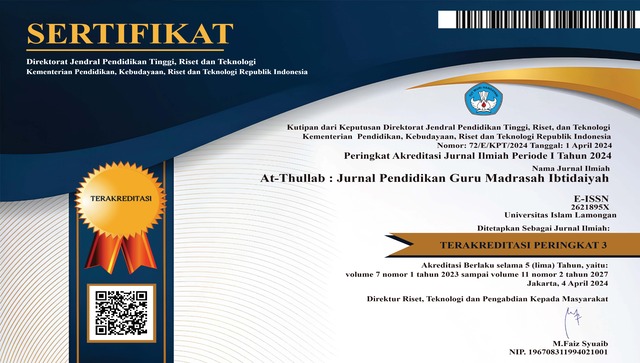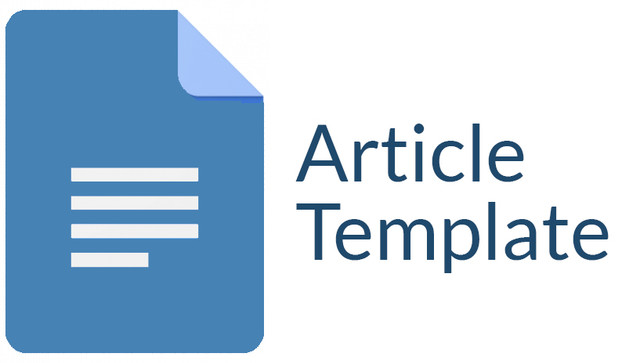Pengaruh Penggunaan Virtual Laboratory PhET Terhadap Hasil Belajar IPA Siswa SD pada Pokok Bahasan Rangkaian Listrik
DOI:
https://doi.org/10.30736/atl.v6i1.750Keywords:
Hasil Belajar, Media Pembelajaran, Virtual laboratory PhETAbstract
Abstrak: Penelitian ini bertujuan untuk mengetahui pengaruh penggunaan media virtual laboratory PhET pada pembelajaran IPA materi rangkaian listrik kelas VI SD. Penelitian ini adalah penelitian Kuantitatif Eskperimen Metode Quasi Eksperimen dengan desain Nonequivalent Control Group Design, dengan menggunakan 2 group Pretest-Posttest Control Group. Penelitian dilaksanakan di SDN Tambakromo 1. Subjek penelitian yaitu 50 siswa kelas VI-A dan VI-B (25 siswa dari tiap kelas). Teknik analisis data yang digunakan termasuk uji normalitas, uji homogenitas, serta uji paired sample t test dan independent sample t test untuk uji hipotesis. Hasil menunjukkan bahwa nilai rata-rata pretest kelas kontrol adalah 60.40 dan rata-rata nilai posttest kelas kontrol adalah 75. Dilihat dari hasil tersebut, terdapat kenaikan nilai. Sedangkan, nilai rata-rata pretest kelas percobaan adalah 61 dan rata-rata nilai posttest kelas percobaan adalah 83.20. Dari hasil tersebut, terdapat kenaikan nilai yang cukup signifikan untuk kelas percobaan. Selain itu, nilai sig. pada uji t kelas percobaan yakni 0.00 < 0.05 dan nilai thitung > ttabel adalah 9.132 > 1.676. Berdasarkan hasil penelitian dapat disimpulkan bahwa terdapat pengaruh yang signifikan dari penggunaan media virtual laboratory PhET terhadap hasil belajar siswa.
Abstract: This study aims to determine the effect of using the virtual laboratory PhET on the sixth graders’ science learning outcomes regarding electrical circuits. This research was a quantitative study using a quasi-experimental method with a nonequivalent control group design with a pretest and posttest. The research was conducted at SDN Tambakromo 1. The research subjects were 50 students from class VI-A and VI-B (25 students from each class). The data analysis techniques included normality test, homogeneity test, as well as the paired sample test and independent sample t test for hypothesis testing. The results showed that the average pretest score for the control class is 60.40 and the average posttest score is 75. It can be seen that there is an increase. Meanwhile, the average pretest score of the experimental class is 61 and the average posttest score is 83.20. The results show a significant increase. Additionally, the sig. value of the t test in the experimental group is 0.00 < 0.05 and the value of tobserved > ttable is 9.132 > 1.676. Based on the results, it can be concluded that there is a significant effect of using virtual laboratory PhET media on the students’ science learning outcomes.Downloads
References
Dwiyanti, A. Na., Riwanto, M. A., & Budiarti, W. N. (2019). Penerapan Laboratorium Virtual Sebagai Upaya Meningkatkan Hasil Belajar dan Karakter Pada Siswa Kelas IV SDN 1 Tambaknegara Tahun Ajaran 2019/2020. PANCAR, 3(2), 275–278.
Handayani, R. D., & Yanti, Y. (2017). Pengaruh Model Pembelajaran Kooperatif Tipe Think Pair Share Terhadap Hasil Belajar PKN Siswa di Kelas IV MI Terpadu Muhammadiyah Sukarame Bandar Lampung. Jurnal Pendidikan Dan Pembelajaran Dasar, 4(2), 107–123. https://doi.org/https://doi.org/10.24042/terampil.v4i2.2220
Hasan, M., & dkk. (2021). Media Pembelajaran. Tahta Media Group.
Hikmah, N., Saridewi, N., & Agung, S. (2017). Penerapan Laboratorium Virtual untuk Meningkatkan Pemahaman Konsep Siswa. Jurnal Kimia Dan Pendidikan, 2(2), 186–195. https://doi.org/http://dx.doi.org/10.30870/educhemia.v2i2.1608
Khasanah, U. (2020). Pengantar Microteaching. Deepublish. https://ejournal.unesa.ac.id/index.php/pensa/article/view/20170
Khusniyah, T. W., Sahruli, J. N., Mariyati, & Ariyanto, R. (2022). Pemanfaatan Laboratorium Virtual IPA Sebagai Upaya. Jurnal Elementary, 5(1), 95–99. https://doi.org/https://doi.org/10.31764/elementary.v5i1.6378
Lusidawaty, V., Fitria, Y., Miaz, Y., & Zikri, A. (2020). Pembelajaran IPA dengan Strategi Pembelajaran Inkuiri Untuk Meningkatkan Keterampilan Proses Sains Dan Motivasi Belajar Siswa di Sekolah Dasar. Jurnal Basicedu, 4(1), 168–174. https://doi.org/https://doi.org/10.31004/basicedu.v4i1.333
Nurhayati, Fadilah, S., & Mutmainnah. (2014). Penerapan Metode Demonstrasi Berbantu Media Animasi Software Phet Terhadap Hasil Belajar Siswa dalam Materi Listrik Dinamis Kelas X Madrasah Aliyah Negeri 1 Pontianak. Jurnal Pendidikan Fisika Dan Aplikasinya (JPFA), 4(2), 1–7. https://doi.org/https://doi.org/10.26740/jpfa.v4n2.p1-7
Nurrokhmah, I. E., & Sunarto, W. (2013). Pengaruh Penerapan Virtual Labs Berbasis Inkuiri terhadap Hasil Belajar Kimia. Chemistry in Education, 2(2).
Prihatiningtyas, S., Prastowo, T., & Jatmiko, B. (2013). Imlementasi Simulasi PhET dan KIT Sederhana untuk Mengajarkan Keterampilan Psikomotor Siswa pada Pokok Bahasan Alat Optik. Jurnal Pendidikan IPA Indonesia, 2(1), 18–22. https://doi.org/https://doi.org/10.15294/jpii.v2i1.2505
Rahayu, S., & Erman. (2017). Penerapan Pendekatan Saintifik dengan Media Simulasi Phet pada Materi Gelombang untuk Meningkatkan Pemahaman Konsep Siswa SMP. PENSA: E-JURNAL PENDIDIKAN SAINS, 5(3).
Rasyidah, K., Supeno, & Maryani. (2018). Pengaruh Guided Inquiry Berbantuan PhET Simulations. Jurnal Pembelajaran Fisika, 7(2), 129–134. https://doi.org/https://doi.org/10.19184/jpf.v7i2.7918
Rohmawati, E. D., & Sukanti. (2012). Pengaruh Cara Belajar dan Penggunaan Media Pembelajaran Terhadap Prestasi Belajar Akuntansi Siswa Kelas XI IPS SMA Negeri 2 Bantul Tahun Ajaran 2011/2012. Jurnal Pendidikan Akuntansi Indonesia, 10(2), 153–171. https://doi.org/https://doi.org/10.21831/jpai.v10i2.918
Rusnita, D. (2019). Pembelajaran Simulasi Phet ( Physics Education and Technology ) dalam Muatan Pembelajaran IPA di Sekolah Dasar. Jurnal Pendidikan Bumi Rafflesia, 2, 1–95.
Saiful. (2021). Tes dan Pengukuran dalam Olahraga. UD. Al-Hasanah.
Sugiyono. (2016). Metodologi Penelitian Kuantitatif, Kualitatif dan R&D. Alfabeta.
Sumarauw, J. M., Ibrahim, M., & Prastowo, T. (2017). Pengembangan Perangkat Pembelajaran. Jurnal Penelitian Pendidikan, 34(58), 25–36. https://doi.org/https://doi.org/10.15294/jpp.v34i1.10909
Sumargo, E., & Yuanita, L. (2014). Penerapan Media Laboratorium Virual (PhET) pada Materi Laju Reaksi dengan Model Pengajaran Langsung. Unesa Journal of Chemistry Education, 3(1), 119–133. https://doi.org/https://doi.org/10.26740/ujced.v3n1
Susanto, S. (2017). Pengembangan Perangkat Pembelajaran IPA dengan Model Problem Based Learning untuk Meningkatkan Keterampilan Berpikir Kritis Siswa. Jurnal Pendidikan Dasar Nusantara, 3, 130–143. https://ojs.unpkediri.ac.id/index.php/pgsd/article/view/747
Downloads
Published
How to Cite
Issue
Section
License
Authors who publish with this journal agree to the following terms:
The journal allow the authors to hold the copyright without restrictions and allow the authors to retain publishing rights without restrictions. Authors retain copyright and grant the journal right of first publication with the work simultaneously licensed under a Creative Commons Attribution-ShareAlike 4.0 International License. that allows others to share the work with an acknowledgement of the work's authorship and initial publication in this journal.
Authors are able to enter into separate, additional contractual arrangements for the non-exclusive distribution of the journal's published version of the work (e.g., post it to an institutional repository or publish it in a book), with an acknowledgement of its initial publication in this journal.
Authors are permitted and encouraged to post their work online (e.g., in institutional repositories or on their website) prior to and during the submission process, as it can lead to productive exchanges, as well as earlier and greater citation of published work (See The Effect of Open Access).
The journal allows third parties (readers, researchers, and others) to share and adapt the material in line with the license. In addition, the material must be given appropriate credit, provided with a link to the license, and indicate if changes were made. If authors remix, transform, or build upon the material, they must distribute their contributions under the same license as the original.













